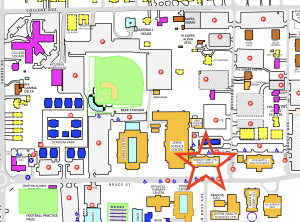Dr. Edmond E. Griffin Planetarium
The Dr. Edmond E. Griffin Planetarium, located on the University of Central Arkansas Campus in the Conway Corporation Center for the Sciences, serves as an astronomy and science education resource center for central Arkansas. The planetarium is part of the outreach component of the Department of Physics and Astronomy, and as such, it supports astronomy teaching on campus, as well as, offers planetarium shows to school groups and the general public.
Spring 2024 Public Shows
The one-hour shows are Friday and Saturday nights starting at 7:00pm. Entry to the planetarium will start at 6:50pm. No admittance once the show starts at 7pm. Seating for Public Shows is on a first-come basis with maximum possible capacity of 94. Please be aware that no food or drink is allowed in the Conway Corporation Center for the Sciences building. Admission is currently free. Donations to the Griffin Planetarium through the Secure Giving link are encouraged.
Shows include a tour of the current evening sky and one of the following full-dome productions.
April 19 and 20: Unveiling The Invisible Universe
“For thousands of years the humans observed the light coming from the night sky with their eyes. In the beginning of the 17th century, the invention of the telescope by Galileo revolutionized our knowledge of the Universe. Finally, in the 20th century with the advent of rockets, it became possible to go above the earth’s atmosphere and observe X-ray and gamma ray radiation which are the marks of the hot and violent Universe. But it is not only light that can give us information about the cosmos. Neutrinos and cosmic rays also provide vital information. Finally, the detection by the LIGO experiment of gravitational waves from two merging black holes opened a new window in astrophysics. This video presents images of the cosmos as revealed by all these different messengers.”

April 26 and 27: Edge of Darkness
“This show features amazing scenes of places never before seen gathered by key space missions that culminated with groundbreaking discoveries in 2015. It features a spectacular flight through the great cliffs on comet 67P, a close look at the fascinating bright “lights” on Ceres, and the first ever close ups of dwarf binary planet Pluto/Charon. Narrated by Hayley Atwell, Agent Carter, from the Marvel Cinematic Universe and the ABC television series.”

May 3 and 4: Supermassive Black Holes: Uncovering the Invisible
“Leading scientists in observational and theoretical studies of black holes and galaxies, industrial experts in cutting-edge big technologies, and professionals in science dissemination have been brought together to set up research projects which will combine the latest state-of-the-art observations, numerical simulations and innovative analytic tools to compare theory with observation, and shed light on the physics of black hole formation in the context of galaxy evolution. This planetarium show presents the environments of the black holes in an impressive and understandable way to the audience.”

May 10 and 11: Invaders of Mars!
“Under the care of Emmy award winning space artist, Don Davis, this beautifully crafted show highlights our ongoing exploration of Mars. We explore the Martian surface as seen by Earth’s various spacecraft “invaders” and use the data gathered to explore the red planet as only CGI can. We fly over the great chasms, canyons and volcanoes, descend amid the icy Martian polar cap, and withstand swirling dust devils. Blinded by the planet-wide storm that often engulf this world, we emerge with a new perspective on the red planet Mars. Includes an optional five-minute end sequence of stereo imagery. Narrated by Tom Baker, of the BBC’s Dr. Who. Winner of four Telly Awards.”

May 17 and 18: Stars of the Pharaohs
“Travel to ancient Egypt to see how science was used to tell time, make a workable calendar, and align huge buildings. You’ll learn about the connection the ancient Egyptians felt with the stars and various astronomical phenomena, and experience some of the most spectacular temples and tombs of the ancient world recreated in all of their original splendor. Telly Award winner. Narrated by John Rhys-Davies, of the Indiana Jones films and The Lord of the Rings films.”

May 24 and 25: Secret Lives of Stars
“Not all stars are created Equal. Some are massive. Others are tiny; almost insignificant. The specific characteristics of a star will determine what type of life it will lead, how long it might live and even the type of death it will die. We will witness the amazing variety of stars and peer into their secret lives. Narrated by Sir Patrick Stewart of TV’s Star Trek the Next Generation and the X-men films. Winner of 4 Telly Awards.”

SUPPORT GRIFFIN:
ABOUT:
Contact:
Department of Physics and Astronomy
University of Central Arkansas phone: 501.450.5900
Conway, AR 72035 fax: 501.852.2286
Staff:
Dr. Scott Austin saustin@uca.edu
Director of Astronomical Facilities
Associate Professor of Astronomy and Physics
Department of Physics and Astronomy
University of Central Arkansas phone: 501.450.5907
Conway, AR 72035 fax: 501.852.2286
History:
From 1987 to 2015, the original UCA planetarium that was located in Lewis Science Center used an electromechanical planetarium projector and a thirty-foot dome to simulate the sky as seen from the surface of the Earth.
The current digital planetarium in the Conway Corporation Center for the Sciences consists of 94 seats under a forty-foot diameter dome onto which an Evans & Sutherland dual projector Digistar 7 system creates a virtual universe. The universe can now be seen from other locations in the universe, such as, in orbit around Saturn, near a binary star system in our galaxy, or from a galaxy a several million light years from the Earth.
The building of a new planetarium was supported by Dr. Sue Griffin, a world-class neuroscientist at the University of Arkansas for Medical Sciences, and named in memory of her husband Dr. Ed Griffin, a long-time faculty member, chair of the UCA Biology Department, and astronomy enthusiast.




